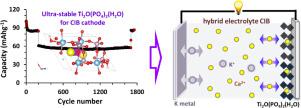Energy Storage Materials ( IF 20.4 ) Pub Date : 2021-09-02 , DOI: 10.1016/j.ensm.2021.08.035 S.J. Richard Prabakar 1 , Woon-Bae Park 1 , Jung Young Seo 1 , Satendra Pal Singh 2 , Docheon Ahn 3 , Kee-Sun Sohn 2 , Myoungho Pyo 1

|
The practical application of calcium ion batteries (CIBs) suffers from a lack of reliable electrode materials that have a long cycle-life and less severe hysteric and capacitive voltage-behavior. Here, we for the first time describe Ti2O(PO4)2(H2O) as a new Ca2+ insertion electrode material for CIBs. Hydrothermally synthesized Ti2O(PO4)2(H2O) can reversibly store ca. 0.51 Ca2+ (ca. 85 mAh g−1) at ca. 2.6 V vs. Ca/Ca2+ at room temperature. This new material displays an unprecedented long cyclability by retaining ca. 95% of the initial capacity after 1500 charge/discharge (C/D) cycles. The structural and compositional characterizations firmly substantiate reversible Ca2+ insertion associated with Ti4+/Ti3+ redox. In-situ X-ray diffraction (XRD) studies reveal that the electrochemical insertion/extraction of Ca2+ ions in Ti2O(PO4)2(H2O) accompanies a minimal dimensional change with no transformation in the crystallographic structure, which is believed to be responsible for the exceptional stability. Bond valence site energy (BVSE) and density functional theory (DFT) calculations also demonstrate that, in contrast to reversible Li+ insertion at ca. 1.7 V in isostructural M0.5TiO(PO4) (M = Cu2+, Mg2+, Co2+, Ni2+, or Fe2+), the significant potential upshift to 2.6 V in Ti2O(PO4)2(H2O) is related to a unique Ca2+ location and migration path, which is ascribed to different orientations of PO4 tetrahedra and TiO6 octahedra. Finally, we construct a CIB cell with a configuration of K metal ‖ Ti2O(PO4)2(H2O) by employing K+-containing hybrid electrolytes, and conceptually show the applicability of Ti2O(PO4)2(H2O) as a viable cathode for CIBs.
中文翻译:

超稳定的 Ti2O(PO4)2(H2O) 作为一种可行的新型钙离子电池 Ca2+ 存储电极材料
钙离子电池 (CIB) 的实际应用缺乏可靠的电极材料,这些材料具有较长的循环寿命和较不严重的迟滞和电容电压行为。在这里,我们首次将 Ti 2 O(PO 4 ) 2 (H 2 O) 描述为一种用于 CIB的新型 Ca 2+插入电极材料。水热合成的 Ti 2 O(PO 4 ) 2 (H 2 O) 可以可逆地储存大约。0.51 Ca 2+ (ca. 85 mAh g -1 ) 2.6 V vs. Ca/Ca 2+在室温下。这种新材料通过保持大约 1500 次充电/放电 (C/D) 循环后初始容量的 95%。结构和组成特征有力地证实了与 Ti 4+ /Ti 3+氧化还原相关的可逆 Ca 2+插入。原位 X 射线衍射 (XRD) 研究表明,Ca 2+离子在 Ti 2 O(PO 4 ) 2 (H 2O) 伴随着最小的尺寸变化,晶体结构没有变化,这被认为是造成异常稳定性的原因。键价位能量 (BVSE) 和密度泛函理论 (DFT) 计算也表明,与可逆的 Li +插入相反,大约为 在同构 M 0.5 TiO(PO 4 )(M = Cu 2+、Mg 2+、Co 2+、Ni 2+或 Fe 2+)中为 1.7 V,Ti 2 O(PO 4 ) 2 (H 2 O) 与独特的 Ca 2+ 有关位置和迁移路径,这归因于 PO 4四面体和 TiO 6八面体的不同取向。最后,我们通过使用含K +的混合电解质构建了具有 K 金属 ‖ Ti 2 O(PO 4 ) 2 (H 2 O)配置的 CIB 电池,并从概念上展示了 Ti 2 O(PO 4 ) 2的适用性(H 2 O) 作为 CIB 的可行阴极。



























 京公网安备 11010802027423号
京公网安备 11010802027423号